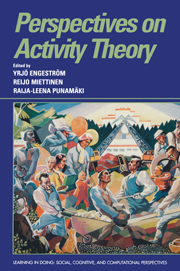Book contents
- Frontmatter
- Contents
- List of contributors
- Series foreword
- Introduction
- Part I Theoretical issues
- 1 Activity theory and individual and social transformation
- 2 The content and unsolved problems of activity theory
- 3 Knowledge as shared procedures
- 4 Activity theory in a new era
- 5 Society versus context in individual development: Does theory make a difference?
- 6 Cultural psychology: Some general principles and a concrete example
- 7 Laws, logics, and human activity
- 8 Collapse, creation, and continuity in Europe: How do people change?
- 9 Activity theory and the concept of integrative levels
- 10 The relevance to psychology of Antonio Gramsci's ideas on activity and common sense
- Part II Language and its acquisition
- Part III Play, learning, and instruction
- Part IV Technology and work
- Part V Therapy and addiction
- Author index
- Subject index
7 - Laws, logics, and human activity
Published online by Cambridge University Press: 05 June 2012
- Frontmatter
- Contents
- List of contributors
- Series foreword
- Introduction
- Part I Theoretical issues
- 1 Activity theory and individual and social transformation
- 2 The content and unsolved problems of activity theory
- 3 Knowledge as shared procedures
- 4 Activity theory in a new era
- 5 Society versus context in individual development: Does theory make a difference?
- 6 Cultural psychology: Some general principles and a concrete example
- 7 Laws, logics, and human activity
- 8 Collapse, creation, and continuity in Europe: How do people change?
- 9 Activity theory and the concept of integrative levels
- 10 The relevance to psychology of Antonio Gramsci's ideas on activity and common sense
- Part II Language and its acquisition
- Part III Play, learning, and instruction
- Part IV Technology and work
- Part V Therapy and addiction
- Author index
- Subject index
Summary
Introduction
There are two underlying ideas in the empirical studies of most psychologists and social scientists that deserve critical attention. The first idea is that the phenomenon that is being explained is determined by certain factors, not directly but through the mediation of certain mechanisms. This means we must first decide which are the dependent variables that represent the phenomenon we want to explain and which are the independent variables from which we will try to find our explanation. We then go on to examine whether there are any correlations between those two categories of variables. If such correlations exist, then it is assumed that they reflect some sort of universal laws, psychological, social, or biological (Figure 7.1). These laws exert their influence through mediating mechanisms, which are represented by intervening variables.
Among the earliest techniques that were developed for the analysis of complicated relationships between variables were factor analysis, regression analysis, and Lazarsfeld's (1955) method of elaboration. Today it is possible, by means of covariance structure analysis, to combine into one analysis the different steps for which the psychologist of the 1950s needed factor and regression analyses (Schoenberg, 1989) or, by means of log-linear models, to correct the technical deficiencies of the elaboration procedure of the 1960s (Hagernaas, 1990, p. 23). In methodological terms, however, these new and elegant techniques introduced nothing new compared to the idea described in Figure 7.1.
- Type
- Chapter
- Information
- Perspectives on Activity Theory , pp. 107 - 114Publisher: Cambridge University PressPrint publication year: 1999
- 7
- Cited by



